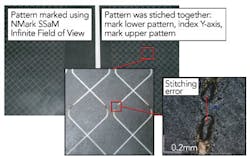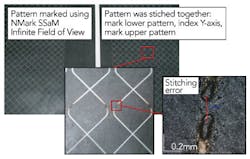Integrated and coordinated servo and galvo control for ultraprecise applications
By Scott Schmidt, Aerotech Inc.
The use of lasers and galvo scanners is widespread in industrial laser material processing. While high-speed marking and barcoding are two of the most popular uses of galvo/laser systems, other applications include laser-engraving, web material processing, and laser micromachining. Each of these galvo processes typically scans a part or array of parts that occupy an area larger than the scanner can "see," also known as its field of view (FoV). Of course, only processing parts smaller than the scanner's FoV severely limits the processing area. Therefore, positioning systems with larger travel ranges must be integrated with the galvo and laser.
Two-controller solution
Achieving both high-speed marking and long travel currently mandates the use of two distinct controllers, one for the scanner and one for servo motion. This method complicates the overall system because the designer must be an expert (or at least conversant) in two automation platforms instead of one. This is not only time-consuming from a system design standpoint, but also raises other issues including potential stitching errors and increased processing time. Stitching errors result from the misalignment of adjacent FoV blocks, as any overall scanner and servo inaccuracies can manifest at the border or seam of adjacent blocks. Because of the discrete nature of these errors, they are often visible to the naked eye and/or large enough to cause part rejection after processing (FIGURE 1).
Just as important, processing time is sacrificed during the "step and settle" servo motion required to position the scanner head over the next block FoV (FIGURE 2). From the galvo's perspective -- indeed, from an overall system point of view -- this time is wasted, as no marking is performed until the servo system has settled to within an acceptable error window. These process limitations are substantial and call for a new approach to scanner applications.
Synchronize the galvo and servo
An innovative automation development, Aerotech's Nmark series, synchronizes both galvo scanner and servo motion (FIGURE 3) to integrate both motion platforms and seamlessly allows the user to control both the servo and scanner axes in one environment. Nmark and its underlying Automation 3200 operating interface allow the user to program in standard CNC G-code, and therefore to operate in a familiar software environment. It does not require the use of multiple programming languages or libraries.
This marriage of servo and galvo axes allows both to move simultaneously and in a coordinated fashion. Because the A3200 motion controller "knows" the location of both the galvo and servo at any point in time, it can easily partition the commanded motion profile to issue long-haul moves to the servo and short, faster moves to the galvo. This allows the galvo's effective FoV to be the entire range of servo stage travel, yielding essentially an infinite field of view (IFoV).
Synchronized scanner and motion
An IFoV is supported by the family of Nmark controller products including both Nmark SSaM (Synchronized Scanner and Motion) and Nmark CLS (Closed Loop Scanner). The former is unique in that it will control any vendor's scanner that supports the industry-standard XY2-100 communication protocol. Galvo FoV correction tables provided from F-Theta lens manufacturers are easily converted and used by this controller's software, allowing galvo "pincushion" and F-Theta "barrel" distortions to be reduced or eliminated.
As a full-feature control module, Nmark SSaM offers an I/O suite that is expandable at either the board/drive or external level -- for instance, via Ethernet. It also enables users to configure the drive for optimal laser control. Laser and scanner delays can be set programmatically or parametrically, native CO2 and Fiber/YAG laser modes may be called and ancillary laser configuration options (first pulse suppression, tickle frequencies, soft start modes, etc.) are present to ease integration of any laser type into the servo/scanner system.
Closed loop scanner
Perhaps the most compelling advantage of Nmark lies with the CLS version. In addition to offering the entire feature set of SSaM, Nmark CLS allows the A3200 motion controller direct access to not only the servo encoder feedback signals but also those of the galvo scanner.
Previous technical articles 1, 2 have detailed the distinct advantages of triggering external events (sampling sensors, firing lasers, etc.) based on real-time position information gathered from the servo system's feedback devices. Triggering on the actual position eliminates effects that external disturbances may have on the process. For example, velocity regulation and settle values become unimportant because the process is not affected by their uncertainty. Also, the latency between when the axis is at the target position and the actual triggering of the output is very low, in the nanosecond range. This allows for much higher speeds than traditional high-latency tracking methods because the chance of missed or overlapping events is avoided.
Of course, if both servo and galvo motion devices are used, a number of complications arise. First, most galvo systems do not expose the raw encoder position feedback to the programmer. Instead, the device appears to the outside world as operating in an open-loop fashion, even though the galvo does operate using a closed-feedback control loop. Further, when both the servo and galvo are moving to (for example) take advantage of Nmark's IFoV feature, which encoder feedback should be the basis of the PSO firing event? Nmark CLS solves this problem with a new patent-pending function called "Infinisync" that combines both the servo and galvo position feedback, and uses both to determine the proper position for PSO pulse firing. This is a significant advantage compared to traditional scanning systems where laser spot placement is almost entirely dependent on the system velocity stability. Thus, if the vector velocity of the scanner mirrors can only be controlled to 0.01%, then the part feature tolerances will suffer. Writing at a modest 1 m/s with 0.01% velocity error could result in the laser firing position being off by as much as 100 μm -- which is much larger than many micromachined features themselves!
Calibration advantage
True measured calibration may be done on the combined servo/galvo system. While most galvo systems merely use a computed correction table to, for instance, remove the barrel distortion inherent with F-Theta lenses, Nmark CLS can accommodate a measured error lookup table that compares marked or measured patterns against the actual position feedback from the galvo motors in addition to any correction files in place for the servo axes underneath. With full system calibration and the controller capability to add additional calibration tables layered on top, configurations using Nmark CLS have a decided accuracy advantage over competing solutions.
References
[1]. "Position Synchronized Output Provides Flexibility," Scott Schmidt and Brian Cox, Quality Magazine, November 2010.
[2]. "Precise Triggering of External Events Based on Axis Position," Brian Cox, Deep Dive, July 2006.
Scott Schmidt is group manager, laser processing & micromachining group, at Aerotech Inc., Pittsburgh, PA, www.aerotech.com.



